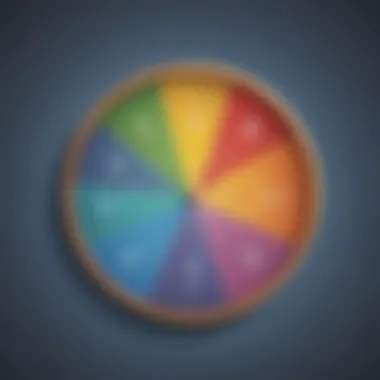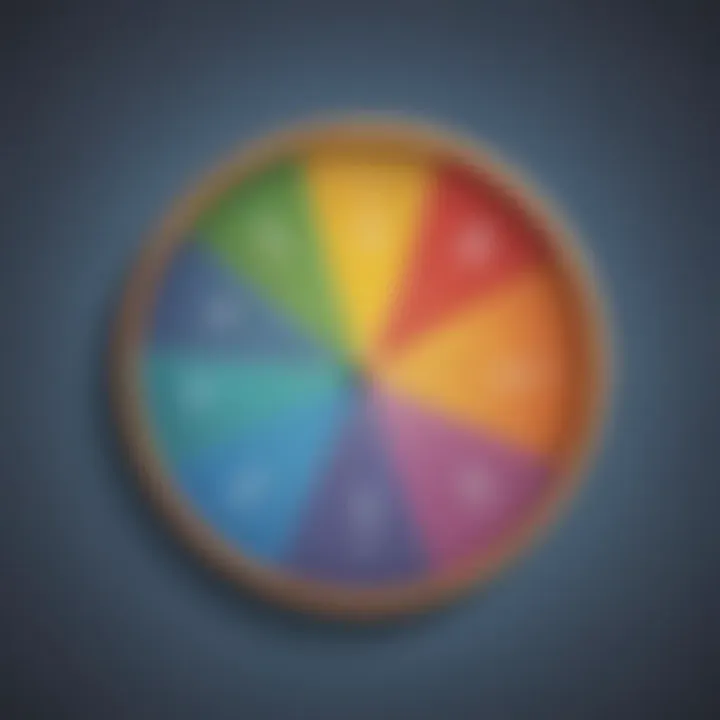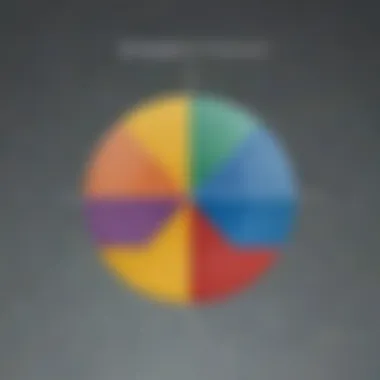Mastering the Art of Simplifying Fractions


Intro
Understanding fractions is like learning how to ride a bike; at first, it can seem a bit shaky, but with the right guidance, it becomes smooth and enjoyable. When it comes to simplifying fractions, grasping the concept is essential for young learners. Simplifying means putting fractions in their most manageable form, making mathematical tasks easier.
In this article, we will journey through the essential elements of fractions, breaking down the components, the methods for simplifying them, and exploring hands-on activities to make learning engaging. Young learners will find that mastering this vital skill not only helps them in math but also aids in developing problem-solving abilities that can carry over into daily life.
Here’s a peek at what we’ll cover: identifying the numerator and denominator, understanding the greatest common divisor, practical steps to simplify fractions, and why this skill matters. Let’s not dawdle; it’s time to get started!
Understanding Fractions
Understanding fractions is like opening a door to a whole new world in the field of mathematics. It lays down the foundation of many concepts that children will encounter later in their education. Fractions represent parts of a whole, and grasping this idea helps young learners make sense of how quantities relate to each other in everyday situations. Whether it's sharing a pizza or dividing a cake, fractions are everywhere!
The journey of learning starts with defining what a fraction is. This principle not only adds value to academic knowledge but also enhances critical thinking and problem-solving skills. Moreover, it fosters an appreciation for the precision in mathematics, teaching children how to analyze and categorize various elements they encounter daily.
Understanding the nitty-gritty of fractions empowers students with the ability to simplify them, recognize equivalent fractions, and perform operations like addition and subtraction. As they navigate through this chapter, learners will uncover the system that governs numbers and quantities, which, in time, builds their confidence and competence in maths.
What is a Fraction?
A fraction can be succinctly defined as a number that expresses how many parts of a whole we have. It consists of two components: the numerator and the denominator. The numerator indicates how many parts we are considering, while the denominator signifies how many parts make up a whole.
For example, in the fraction ( \frac34 ), the number 3 (numerator) tells us we're looking at three parts, while the 4 (denominator) tells us that these three parts come from a whole divided into four equal segments. In real life, this could mean having three out of four slices of a pie.
Parts of a Fraction
Understanding the parts of a fraction is crucial to simplifying it effectively. Every fraction is made up of two essential pieces: the numerator and the denominator.
Numerator
The numerator plays a pivotal role in fractions. It’s the upper part of the fraction, and its primary function is to indicate how many parts are being considered. Think of it like your score in a game: it reflects your success. For instance, if you have ( \frac25 ), the number 2 is telling you you’ve got two pieces out of the five total pieces.
Key Characteristic: The numerator is a versatile figure; it can be big, small, or even zero! This flexibility allows learners to work with a variety of situations. When the numerator is larger than the denominator, you have what's called an improper fraction, which often leads to whole numbers, helping students to understand how parts relate to wholes.
Unique Feature: One fascinating aspect of the numerator is that it can also change the fraction's value significantly. For instance, ( \frac48 ) is equivalent to ( \frac12 ) when simplified, illustrating that the numerator's role is not just about counting parts but about defining value as well.
Denominator
The denominator, sitting comfortably below the numerator, is just as important. It tells us into how many total parts the whole is divided. Returning to our ( \frac34 ) example, the number 4 means the whole is divided into four equal pieces.
Key Characteristic: The denominator is what shapes the fraction’s context. A fraction like ( \frac24 ) can mean a lot if we apply it to different situations, like measuring ingredients in cooking or calculating scores in games. It brings clarity on the whole's dividing structure.
Unique Feature: Interestingly enough, the denominator also plays a role in determining whether a fraction is proper, improper, or even representing a whole number. If a denominator becomes 1, then the fraction simplifies to a whole number, reflecting an interesting shift in its meaning.
"Understanding the parts of a fraction paves the way for mastering the art of simplifying them, a skill that pays off in maths and life."
In summary, a solid grasp of fractions—comprehending what they are and identifying their parts—sets the stage for simplifying fractions effectively. This foundational knowledge will enable children to not just perform mathematical operations with confidence but also apply it to real-life situations where fractions come into play.
Importance of Simplifying Fractions
When it comes to fractions, simplification is a cornerstone skill, making it much simpler to work with numbers. To put it plainly, simplifying fractions helps you see things clearly without the clutter. Have you ever had a recipe that called for something like 4/8 of a cup? Sure, you could use that, but knowing it simplifies to 1/2 might just make your cooking a tad easier. Understanding why simplification is key not only enhances mathematical skills but also helps foster an appreciation for the purity of numbers.
Why Simplify?


There are multiple reasons why simplifying fractions is of immense importance:
- Clarity in Understanding: Simplifying a fraction allows students, and even adults, to grasp the concept without the frills of working with larger numbers. It’s easier to see patterns in numbers, and it makes comparing fractions a breeze.
- Efficient Calculations: When numbers are smaller, calculations become faster and less error-prone. If you’ve ever spent ages on a math problem just to realize your fractions were bloated, you know what I mean.
- Common Basis: Simplified fractions help students identify and relate to common denominators. This understanding is crucial as students advance in their numerical journey.
In short, simplifying fractions isn’t just a mathematical task; it lays down the groundwork for more advanced concepts.
Real-Life Applications
The implications of mastering fraction simplification stretch far beyond the classroom. Here are a few everyday scenarios where simplification comes in handy:
- Cooking and Baking: Anyone who has tried doubling or halving a recipe knows that fractions are at play, and simplifying can save both time and mental gymnastics.
- Construction Projects: Whether you’re measuring lengths of wood or determining paint quantities, precise fractions make all the difference. A carpenter wouldn’t want to make a mistake because they didn’t simplify a measurement.
- Financial Calculations: Many jobs, particularly in retail or accounting, necessitate quick calculations. Simplifying fractions helps not only in getting the correct figure but also in ensuring more efficient operations.
- Sports Statistics: Statisticians in sports work tirelessly with numbers. Simplifying fractions helps in conveying percentages of scores or wins more effectively.
In sum, the skill of simplifying fractions isn't just a classroom exercise; it has real-world significance. It sharpens critical thinking and aids in problem-solving, which, as we all know, is not just a fancy skill in math but a tool for life.
Basic Concepts in Simplification
Simplifying fractions isn't just a chore; it's a key skill that makes working with numbers a little easier. Think of it like clearing away the clutter in a messy room—once you simplify, the important stuff stands out more clearly. In this section, we will explore why understanding the basic concepts behind simplification is necessary, especially for those younger learners who are just getting cozy with math.
One of the biggest advantages of knowing the basic concepts is that it builds a solid foundation. If children grasp the reasoning behind why we simplify fractions, they’ll find it easier to tackle more complex problems later on. Understanding these concepts not only boosts their confidence but also their mathematical intuition. When faced with real-life situations—like splitting a pizza or dividing crayons among friends—being able to simplify fractions makes problem-solving straightforward.
Greatest Common Divisor
At the heart of simplifying fractions lies the Greatest Common Divisor, often referred to as GCD. This little fellow is the largest number that can evenly divide both the numerator and the denominator of a fraction. Why is this important, you ask? Well, identifying the GCD gives us the jumpstart we need to simplify a fraction to its bare bones.
For instance, if we take the fraction 8/12, the numbers 8 and 12 share common divisors like 2 and 4, but their GCD is 4. If we divide the numerator and denominator by 4, we turn 8/12 into 2/3. Just like that, the fraction is in its simplest form! Here’s how to find the GCD:
- List the factors: Write down all the factors of both numbers.
- Identify the common factors: Look for any factors that appear in both lists.
- Choose the greatest: The biggest number from the common factors is your GCD.
Remember: Finding the GCD is like finding the strongest link in a chain; it makes the whole setup stronger and easier.
Factoring Numbers
Factoring numbers is another important piece of the simplification puzzle. This is simply breaking down a number into the products of its factors. For example, let’s take the number 12. It can be factored into 3 and 4, because 3 times 4 equals 12. Or, you could express it as 2 times 6. Both pairs work!
In the context of fractions, factoring helps us identify the GCD, which we previously discussed. Once we factor both the numerator and the denominator, we can see what common factors exist. This makes the process of finding the GCD a lot simpler. Here are some tips for factoring numbers effectively:
- Start Small: Repeatedly divide the number by its smallest prime factors.
- Use a Factor Tree: This can visually break down numbers into their factors.
- Practice Makes Perfect: The more you practice factoring, the quicker you will become at recognizing common factors.
Step-by-Step Process to Simplify Fractions
Understanding how to simplify fractions is a crucial aspect of mastering basic mathematics. Being able to reduce a fraction down to its simplest form makes various math tasks more manageable. This step-by-step approach allows students to gain confidence in their mathematical abilities. By breaking it down, we can make the process less daunting and more intuitive.
Identify Numerator and Denominator
To start off, one must first understand the very components of a fraction—the numerator and the denominator. The numerator is the number above the line, representing how many parts we have. Meanwhile, the denominator, which is below the line, indicates the total number of equal parts in the whole. For example, in the fraction 3/4, "3" is the numerator and "4" is the denominator. Recognizing these parts correctly lays the foundation for all further simplifications.
Find the Greatest Common Divisor
Prime Factorization
Prime factorization is a method where we break down numbers into their prime factors. This is particularly useful in finding the greatest common divisor (GCD). The beauty of prime factorization is its systematic approach: you take a number and divide it down until all you have left are primes, the basic building blocks of all numbers. For instance, to find the GCD of 18 and 24, you break them down:


- 18: 2 x 3 x 3
- 24: 2 x 2 x 2 x 3
Here, the prime factors common to both are 2 and 3, which multiplies to give us a GCD of 6. Prime factorization simplifies the task of finding the GCD, making it a favored approach for many when looking to simplify fractions.
Listing Factors
Alternatively, listing factors can also lead us to the GCD. This method involves jotting down all factors of a number and identifying the largest shared factor between them. Using the same numbers, 18 and 24:
- Factors of 18: 1, 2, 3, 6, 9, 18
- Factors of 24: 1, 2, 3, 4, 6, 8, 12, 24
By comparing, the greatest common factor here is once again 6. While this method is quite straightforward, it can get tedious especially with bigger numbers or when learning. Yet, it provides a clear visual representation of how numbers relate to each other.
Divide Both Parts by GCD
Once the GCD is known, the next step is straightforward: divide both the numerator and the denominator by the GCD. Let’s take our previously simplified fraction of 18/24. Since we found the GCD to be 6, we would divide both parts by 6.
- 18 ÷ 6 = 3
- 24 ÷ 6 = 4
This gives us a simplified fraction of 3/4. By efficiently reducing fractions in this way, students not only ease their math workload but also develop analytical skills that will benefit them in advanced mathematical concepts.
Remember, practice makes perfect! Regularly simplifying fractions will help solidify these concepts in your mind.
Examples of Simplifying Fractions
When it comes to grasping fractions, seeing examples can make all the difference. Understanding how to simplify fractions is a practical skill that students will carry with them throughout their lives. By looking at real examples, children can better appreciate the process of simplification, allowing them to relate to fractions not just as numbers, but as representations of parts of a whole.
Simple Fractions
Simple fractions are those that are easy to understand and usually consist of small numbers. For instance, let’s take the fraction 4/8. At first glance, it might seem that this fraction is in its simplest form. However, that’s not the case. Here’s how to simplify it step-by-step:
- Identify the numerator and denominator: Here, the numerator is 4, and the denominator is 8.
- Find the greatest common divisor (GCD): The GCD of 4 and 8 is 4.
- Divide both parts by the GCD: By dividing both the numerator and the denominator by 4, we get [ \frac4 \div 48 \div 4 = \frac12 ]. Thus, the simplest form of 4/8 is 1/2.
This kind of fraction teaches students the basic idea behind simplification in an easy-to-digest manner. The beauty of understanding simple fractions lies in the confidence it builds for tackling more complex numbers later on.
Complex Fractions
Complex fractions involve larger numbers or can have numerators and denominators that are both multi-component expressions. To break this down, let’s analyze the fraction 18/24. Simpler than it looks, we can follow the same steps as before:
- Identify the numerator and denominator: For 18/24, the numerator is 18 and denominator is 24.
- Finding the GCD: The largest common factor between these two is 6.
- Divide both by GCD: [ \frac18 \div 624 \div 6 = \frac34 ] gives us the simplest form of the fraction.
Aside from providing insight into processing fractions, complex fractions also cultivate critical thinking. By engaging with larger numbers, students start to understand how numerous aspects of mathematics can connect.
Key takeaway: Practicing both simple and complex fractions encourages learners not only to simplify but also to develop an appreciation for the beauty of numbers and their relationships.
Through careful examples, students can see the importance of simplification clearly. It serves not only the mathematics curriculum but also the broader goal of nurturing confident and capable learners.
Common Mistakes to Avoid
Understanding the process of simplifying fractions is crucial, yet many learners encounter pitfalls along the way. Recognizing these common mistakes can save a lot of confusion and ensure a solid grasp of the material. By avoiding these errors, students can become more confident and proficient with fractions, leading to greater success in math overall.
Overlooking GCD


One common blunder that students often make when simplifying fractions is overlooking the greatest common divisor (GCD). This error can happen when learners don’t take the time to fully analyze the numbers involved. For example, if a student has the fraction 12/16, they might mistakenly think they can simplify by just dividing by 2, resulting in 6/8. However, the GCD of 12 and 16 is actually 4, which means the correct simplification would be 3/4.
Why is the GCD so important? The GCD helps in ensuring that both the numerator and denominator are divided by the largest number possible, resulting in the simplest form of the fraction. Not utilizing the GCD can lead to results that, although reduced, are not the simplest form available.
Here’s a tip for identifying the GCD:
- List Factors: Write out the factors of both numbers and find the largest one they share.
- Prime Factorization: Break down both numbers into their prime factors and identify the common ones.
The confusion surrounding GCD can slow down learning, so emphasizing its role can prevent students from getting tangled in more complicated arithmetic later on.
Incorrectly Dividing Parts
Another prevalent mistake is incorrectly dividing the numerator and denominator. When learners try to simplify fractions, they might forget to apply the GCD correctly, or they may divide by the wrong number entirely. Suppose a student has the fraction 18/24. If they don't calculate the GCD and instead choose to divide both parts by 2, they get 9/12, which is still not in simplest form. The GCD here is 6, so the correct simplification is 3/4.
The importance of careful calculation cannot be overstated. Here are a few reminders to avoid incorrectly dividing parts:
- Double-Check Division: Always double-check calculations to confirm they are dividing both parts accurately.
- Use the GCD as a guide: Ensure that you always employ the correct greatest common divisor.
Remember, simplifying fractions is not just about getting the math correct; it’s also about developing discipline in checking work. Small errors can lead to bigger confusion down the road.
Additional Resources for Practice
Practicing the simplification of fractions can be a daunting task for many children. However, with the right tools and resources, it becomes much more manageable. In this section, we’ll explore various methods that can help reinforce concepts while making learning more engaging. Equipping children with additional resources enables them to practice effectively, leading to better understanding and retainment of fraction concepts.
Worksheets and Exercises
Worksheets are an excellent way for young learners to practice their skills in a structured manner. These can vary in difficulty, allowing children to start simple and gradually tackle more complex tasks.
- Repetition is Key: By working through various problems, students can familiarize themselves with the process of simplification. The more they practice, the easier it becomes.
- Visual Learning: Worksheets can incorporate visuals, which help children grasp concepts. For instance, diagrams showing shaded parts of shapes can represent fractions alongside numerical problems.
- Self-Assessment: Including answer keys or solutions at the end allows students to check their work. This kind of feedback is crucial. It's like having a safety net while trying to understand where mistakes might happen.
When creating or looking for worksheets, consider:
- Incremental Difficulty: Start from very basic fractions, like 1/2 or 2/4, and move to harder ones like 15/25.
- Mixed Types: Include various problems – some requiring identifying GCD and others involving direct simplifications.
- Real-World Scenarios: Pose questions based on real-life situations where fractions are required, like sharing pizza, which can make it relatable.
Online Games and Tools
Transforming learning into play is a brilliant strategy, especially for younger students. Online platforms provide a diverse range of games aimed at helping children solidify their understanding of fractions.
- Interactive Learning: Online games often incorporate interactive elements that keep kids engaged. Instead of a mundane worksheet, they can play a game where they help a character score points by simplifying fractions correctly.
- Immediate Feedback: Unlike traditional practice, online games typically provide instant feedback. This quick response helps reinforce concepts effectively. Kids can see their mistakes right away and learn from them without delay.
- Variety of Approaches: Games can present fractions in numerous ways, ensuring a well-rounded understanding. A student might encounter fractions represented visually, numerically, or through word problems.
When exploring online games and tools, look for:
- Reputable Sources: Websites like Khan Academy or Cool Math Games provide reliable educational content.
- Age Appropriateness: Ensure the games cater to your child’s understanding level. Some might be too complex, leading to confusion instead of learning.
- Balance Between Fun and Learning: Check reviews or test games beforehand to make sure they’re beneficial. The goal is to have fun but also learn effectively.
"Engaging resources can transform a once tedious task into an exciting adventure of learning."
By utilizing both worksheets and online games, students can practice simplifying fractions in various ways, reinforcing their skills. These additional resources are invaluable for boosting confidence and capability in handling fractions during their educational journey.
Culmination
Simplifying fractions is not just a classroom task—it’s a crucial skill that spills over into many aspects of life. By understanding the simplest form of a fraction, young learners can grasp foundational mathematical principles that will serve them well throughout their academic journey.
Recap of Key Points
In this article, we’ve covered several important elements:
- Understanding Fractions: We explored what fractions are, including their parts: the numerator and the denominator. This introduction sets the stage for working with and simplifying these mathematical expressions.
- Importance of Simplifying Fractions: Simplification isn’t just about tidiness; it enhances comprehension and offers practicality in real-world applications, from cooking measurements to financial calculations.
- Basic Concepts in Simplification: The greatest common divisor plays a pivotal role in reduction. Knowing how to factor numbers properly can make the process much smoother.
- Step-by-Step Process to Simplify Fractions: We've outlined practical steps—identifying the numerator and denominator, finding the GCD, and effectively dividing both parts by the GCD, which empowers students to tackle fractions independently.
- Examples of Simplifying Fractions: Real-life examples help solidify the concept, showing students that fractions are not just theoretical but also applicable in their daily experiences.
- Common Mistakes to Avoid: Recognizing potential pitfalls, such as overlooking the GCD or misdividing parts, makes for a more cautious and informed approach.
- Additional Resources for Practice: Worksheets, exercises, and online tools provide platforms for further learning and practice, helping reinforce their skills and understanding.
In summary, grasping the simplest form of a fraction lays down a solid foundation for higher-level math and problem-solving skills. Understanding these concepts not only aids in academic performance but also develops logical thinking—a valuable skill in all walks of life. Ensure that practice continues beyond just the classroom to truly embed this skill.







